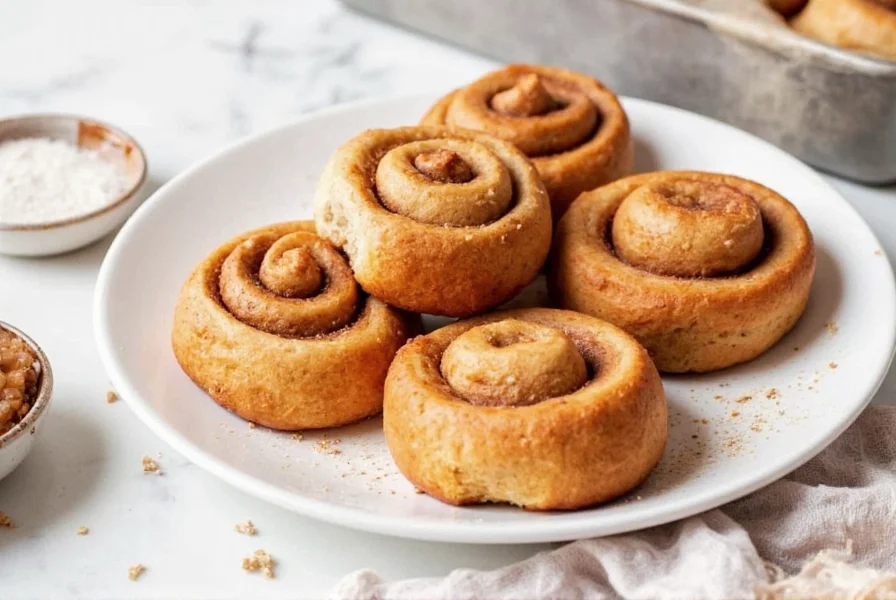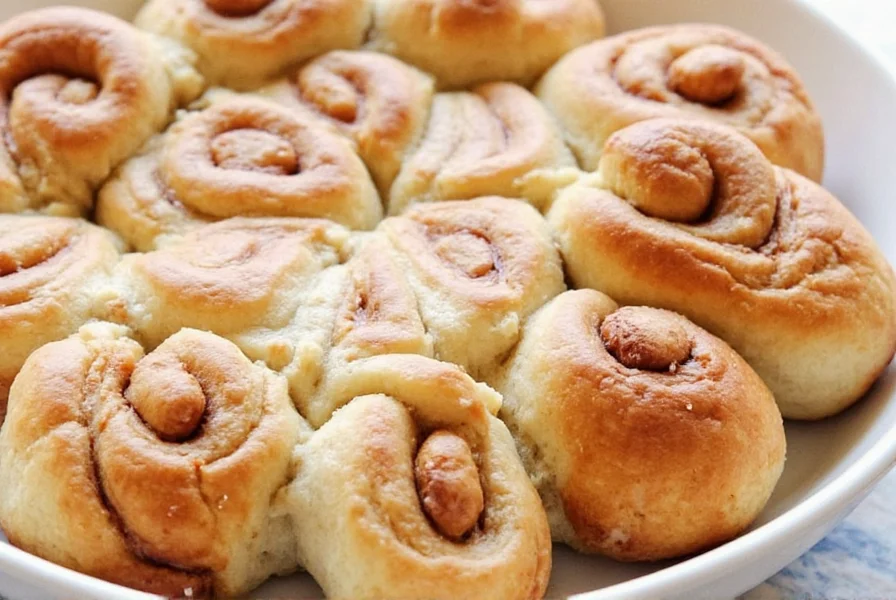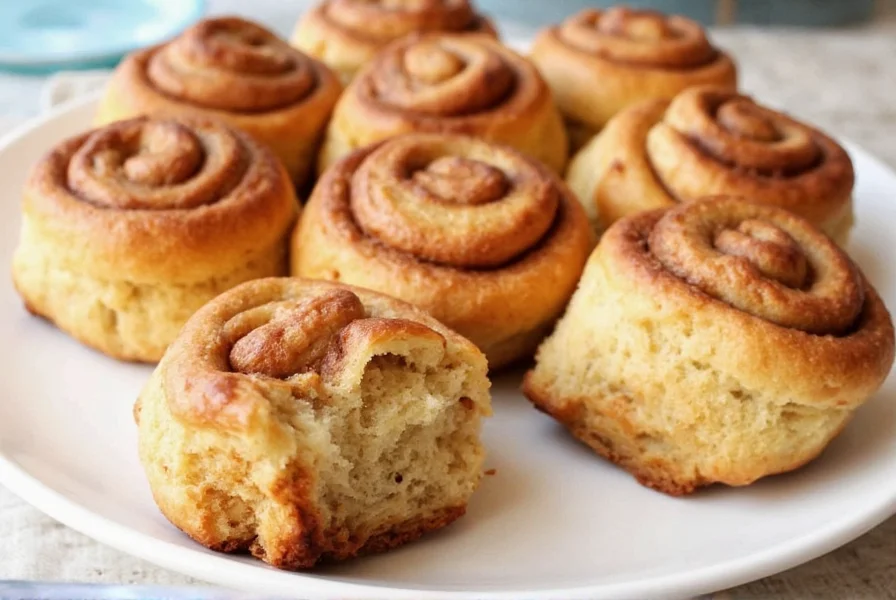If you're craving warm, gooey cinnamon buns but follow a plant-based diet or have dairy allergies, vegan cinnamon buns offer the perfect solution. These delectable pastries prove you don't need dairy or eggs to create bakery-quality results. The secret lies in thoughtful ingredient substitutions that maintain the signature soft dough and rich cinnamon swirl that makes this treat so irresistible.
The Essential Components of Perfect Vegan Cinnamon Buns
Creating exceptional vegan cinnamon buns requires understanding which traditional ingredients need replacement and why certain plant-based alternatives work best. Unlike conventional recipes that rely on butter, milk, and eggs, vegan versions use carefully selected substitutes that preserve moisture, structure, and flavor.
| Traditional Ingredient | Vegan Alternative | Why It Works |
|---|---|---|
| Butter | Refined coconut oil | Melts at similar temperature, provides richness without coconut flavor |
| Milk | Unsweetened almond or oat milk | Neutral flavor, proper fat content for dough development |
| Eggs | Flax or chia "eggs" | Binds ingredients while adding moisture and structure |
| Traditional Icing | Coconut cream-based frosting | Creates creamy texture without dairy |
Mastering the Vegan Cinnamon Bun Dough
The foundation of exceptional vegan cinnamon buns lies in the dough. Many beginners struggle with vegan dough being too dense or dry, but proper technique solves these issues. The key is understanding how plant-based ingredients interact differently than their dairy counterparts.
When making easy vegan cinnamon bun recipe dough, temperature control proves critical. Vegan dough typically requires slightly warmer liquid ingredients (around 110°F) to properly activate the yeast, as plant-based milks often contain fewer natural sugars than dairy milk. Don't skip the proofing step—watch for that bubbly, foamy consistency that confirms your yeast is active before incorporating it into the flour mixture.
For the perfect vegan cinnamon bun dough, use bread flour rather than all-purpose. The higher protein content creates better gluten development, which compensates for the lack of eggs. Knead the dough for 8-10 minutes until it becomes smooth and elastic. The windowpane test (stretching a small piece of dough thin enough to see light through without tearing) remains the best indicator of proper gluten development in vegan cinnamon buns without eggs.

Creating the Signature Cinnamon Swirl
The filling makes or breaks any cinnamon bun, and vegan versions require special attention to achieve that signature sticky, spiced swirl. Traditional recipes often use butter in the filling, but vegan alternatives work beautifully with the right approach.
For the best results, combine coconut oil with organic cane sugar, premium cinnamon, and a pinch of nutmeg. The oil should be softened but not melted—think peanut butter consistency. This texture allows for even spreading without soaking into the dough too quickly. Many bakers make the mistake of using liquid sweeteners like maple syrup in the filling, which creates excess moisture and prevents proper layering.
When rolling your vegan cinnamon buns from scratch, start with a rectangular shape about 16x12 inches. Roll tightly from the long edge, using a bench scraper or dental floss to slice clean portions. Place them close together in the baking dish—the buns will expand and touch during proofing, creating that desirable pull-apart texture.
Overcoming Common Vegan Baking Challenges
Vegan baking presents unique challenges, but understanding the science behind ingredient interactions helps overcome them. Here are solutions to the most frequent issues:
- Dense texture: Often caused by over-flouring. Measure flour by weight (450g per batch) rather than volume for accuracy in your best vegan cinnamon roll ingredients
- Dry buns: Results from insufficient fat content. Increase coconut oil by 1-2 tablespoons if your climate is particularly dry
- Flat rolls: Usually indicates dead yeast. Always test yeast in warm liquid with a pinch of sugar before incorporating
- Separating layers: Caused by melted filling. Chill the rolled dough for 15 minutes before slicing
Delicious Variations to Explore
Once you've mastered the basic how to make vegan cinnamon buns from scratch, experiment with these popular variations:
For a gluten-free vegan cinnamon buns option, substitute 400g gluten-free flour blend (with xanthan gum included) for the bread flour. Add an extra flax egg to compensate for the lack of gluten structure. Let the dough rest for 30 minutes before shaping to allow the flours to hydrate fully.
Those seeking healthy vegan cinnamon roll substitutes can reduce sugar by 25% and incorporate 1/4 cup of apple sauce into the dough. While the texture becomes slightly denser, the natural sweetness balances the reduced sugar. For added nutrition, sprinkle chopped walnuts or pecans between the layers.

Serving and Storage Recommendations
Vegan cinnamon buns taste best when fresh from the oven, but proper storage maintains quality for several days. Cool completely before storing in an airtight container with parchment between layers. They keep well at room temperature for 2 days or refrigerated for up to 5 days.
For longer storage, freeze unbaked rolls after shaping. Place them on a parchment-lined baking sheet until solid, then transfer to freezer bags. When ready to bake, thaw overnight in the refrigerator and allow 2-3 hours for final proofing at room temperature before baking. This method preserves the traditional cinnamon buns vs vegan version quality difference that many notice with day-old pastries.
Frequently Asked Questions
Can I make vegan cinnamon buns without yeast?
Yes, you can create yeast-free vegan cinnamon buns using baking powder and baking soda as leavening agents. Replace the yeast mixture with 1 1/2 cups of non-dairy milk warmed to 110°F, 2 teaspoons baking powder, and 1/2 teaspoon baking soda. The texture will be more like a sweet roll than traditional pull-apart cinnamon buns, but still delicious.
Why do my vegan cinnamon buns come out dry?
Dry vegan cinnamon buns typically result from insufficient fat content or overbaking. Ensure you're using the recommended amount of coconut oil (not less), and check for doneness at the minimum baking time. The internal temperature should reach 190°F. Adding 1-2 tablespoons of non-dairy milk to the dough can also improve moisture retention.
What's the best vegan substitute for cream cheese icing?
The best vegan cream cheese icing alternative combines 8 ounces of vegan cream cheese, 1/4 cup softened coconut oil, 2 cups powdered sugar, 1 teaspoon vanilla extract, and 1-2 tablespoons of non-dairy milk. Whip until smooth. For a simpler option, use coconut cream thickened with powdered sugar and vanilla.
How do I prevent my vegan cinnamon buns from becoming too dense?
To prevent dense vegan cinnamon buns, measure flour by weight (450g), ensure your yeast is active before using, knead the dough sufficiently (8-10 minutes), and allow proper proofing time until doubled in size. Using bread flour instead of all-purpose provides better structure without density.











 浙公网安备
33010002000092号
浙公网安备
33010002000092号 浙B2-20120091-4
浙B2-20120091-4